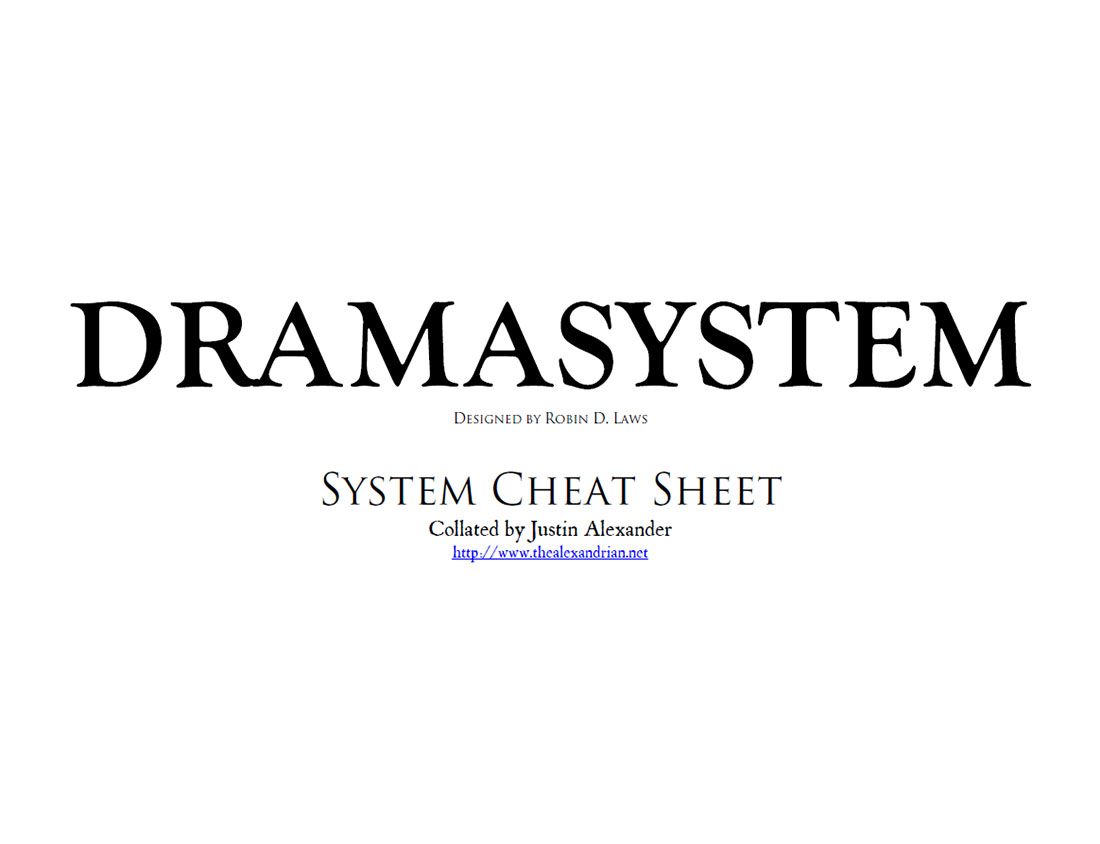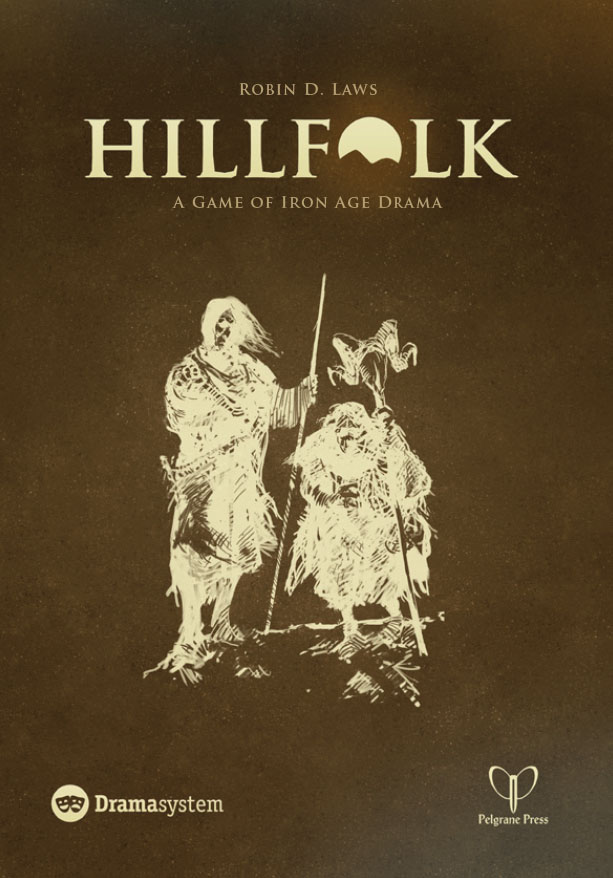Robin D. Laws’ DramaSystem is tucked away inside the Hillfolk roleplaying game. Hillfolk is kind of an odd duck of a book: There’s about 50 pages of generic rules describing the DramaSystem engine. There’s 15-20 pages of setting material pertaining specifically to Hillfolk: A Game of Iron Age Drama. And then there’s another 150 pages providing everything you need to play in 30 other settings. In other words, there’s 200+ pages of material for the DramaSystem and only 15-20 pages of Hillfolk in there. The entire book is really designed as a generic resource for the DramaSystem, but it’s not branded, presented, or sold as such.
The raison d’être for the DramaSystem lies with Laws’ breakdown of fiction into procedural scenes and dramatic scenes: “In procedural scenes, characters confront and overcome obstacles — “they fight opponents, conduct chases, investigate mysteries, explore unfamiliar environments, and so on. (…) In a dramatic scene, the main characters confront internal obstacles, seeking emotional reward from people they care deeply about, for good or ill.” The majority of RPGs focus almost exclusively on procedural content. Laws wanted to design a storytelling game which specifically focused on creating and playing through dramatic scenes.
Laws believes that one of the primary obstacles to effective dramatic scenes in traditional roleplaying games lies in the fact that players tend to default to no, convinced that their characters are all possessed of a steely, unbreakable resolve that will never buckle, and thus creating flat, repetitious scenes that never build, centered around boring characters who never grow or change. (He says this in like the most insulting way possible, claiming that anyone who refuses to play games in an authorial stance is in denial about what roleplaying games are really all about, and that anyone who refuses to come to Jesus after experiencing the true glories of the DramaSystem is basically a petulant man-child who should be kicked out of your group. But except for the couple of pages where he goes on that Bizarro World rampage, he’s not fundamentally wrong.)
The DramaSystem structurally works to overcome these impulses by (a) specifically focusing gameplay on the dramatic content, (b) redefining “success” in dramatic instead of personal terms, and (c) mechanically encouraging (and, in some cases, forcing) characters to yield in dramatic scenes. The central mechanic around which these structures are built is simply framing scenes in terms of petitioners (and the emotional need they want fulfilled) vs. granters (and why they won’t give it).
One interesting feature in this is that Laws seems to identify these mechanics as modeling the storytelling techniques used by creators in other mediums. But that’s not really accurate. What the mechanics actually model is a process of literary criticism. (It is, in fact, the same lit-crit that Laws uses in Hamlet’s Hit Points.) Intriguingly, that’s also what the game’s mechanics feel like in play: A literary critique of the narrative you’re spontaneously generating.
The result feels very unique in play, and it definitely succeeds in forcing a group to aggressively focus on a type of character interaction which is, in fact, rather rare in most tabletop roleplaying. Having played it only a handful of times, I’m not 100% sure it actually succeeds as a game. But it definitely succeeds at being a very interesting creative exercise, and if nothing else I honestly think most groups would benefit from playing a half dozen sessions of it or so. The lessons you’ll learn (both individually and collectively) will likely have a very positive impact as they feed back into your other games.
SYSTEM CHEAT SHEETS
I’ve designed system cheat sheets for a number of RPGs and STGs now. This one is designed to be used with any DramaSystem setting (the 30 from the Hillfolk corebook, the 25 from the Blood on the Snow supplement, or any which you create yourself). For those unfamiliar with them: These cheat sheets summarize all the rules for the game — from basic action resolution to advanced options. It’s a great way to get a grip on a new system and, of course, it also provides a valuable resource at the table for both the GM and the players. (For more information on the procedure I follow when prepping these cheat sheets, click here.)
HOW I USE THEM
I generally keep a copy of the system cheat sheet behind the GM screen for quick reference and also provide copies for all of the players. I also keep at least one copy of the rulebook available, of course, and the cheat sheet probably won’t make much sense to you if you haven’t read it yourself. But the goal of the cheat sheet is to consolidate all of the mechanical content of the game, eliminating book look-ups: Finding something in a handful of pages is a much faster process than paging through hundreds of pages in a rulebook.
The organization of information onto each page of the cheat sheet should, hopefully, be fairly intuitive:
Page 1: This page contains the broad, general principles of the system.
Page 2: This page contains virtually everything you need in order to frame and play through scenes (which is the heart of the system).
Page 3: Something of a miscellanea. This includes general principles and rules for the GM, but the rules for player v. player conflict also got bumped onto this page due to lack of space.
MAKING A GM SCREEN
These cheat sheets can also be used in conjunction with a modular, landscape-oriented GM screen (like the ones you can buy here or here).













